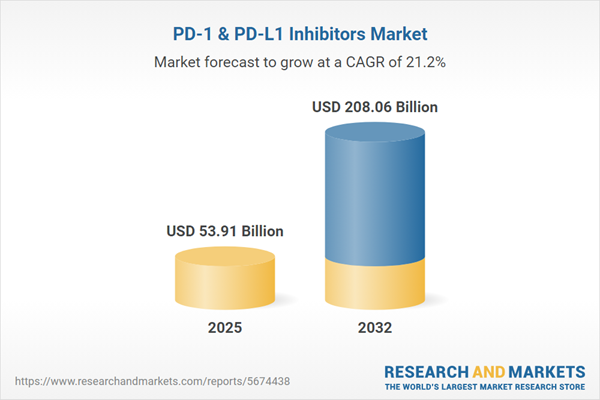Speak directly to the analyst to clarify any post sales queries you may have.
The PD-1 & PD-L1 Inhibitors Market is undergoing strategic transformation, prompting healthcare executives to continuously adjust operational and compliance frameworks. With immunotherapy shaping oncology pathways globally, maintaining competitive relevance requires immediate and ongoing engagement with both regulatory updates and advancing technologies.
Market Snapshot: PD-1 & PD-L1 Inhibitors Market
In 2024, the global PD-1 & PD-L1 Inhibitors Market reached a value of USD 44.61 billion, with projections rising to USD 53.91 billion in 2025 and a robust surge to USD 208.06 billion by 2032. Market acceleration reflects increased adoption of immune checkpoint inhibitors, the rise of biologic therapy innovations, and more adaptable international regulatory policies. Pharmaceutical organizations, biotechnology firms, and clinical research consortia are investing in shared research initiatives and collective market access, making PD-1 & PD-L1 inhibitors central to oncology treatment paradigms globally. Hospitals and healthcare systems are prioritizing deployments, highlighting the strategic need for agile market adoption and integrated supply planning to support evolving patient care requirements.
Scope & Segmentation: Market Structure and Core Segments
- Product Types: Leading therapies including cemiplimab, nivolumab, pembrolizumab, atezolizumab, avelumab, and durvalumab drive customized oncology approaches, reflecting continual scientific progress and updated treatment protocols across centers.
- Indications: Applications are concentrated in key cancers such as bladder, lung, head and neck, melanoma, and renal cell carcinoma. Ongoing research extends clinical application to additional tumor types, supporting more inclusive care policies.
- End Users: Hospitals, research institutions, and specialty clinics each play pivotal roles in adopting PD-1 & PD-L1 inhibitor protocols, directly informing patient access and optimized treatment delivery within oncology workflows.
- Distribution Channels: Hospital and retail pharmacies, complemented by online distribution options, expand geographic reach and enable customization for patient populations through adaptive fulfillment strategies.
- Routes of Administration: Both intravenous and subcutaneous methods promote operational flexibility, facilitate an improved patient experience, and integrate easily into diverse healthcare provider settings, from large hospitals to smaller clinics.
- Companies: Industry leaders such as AstraZeneca, Bristol-Myers Squibb, Merck & Co., Roche, Merck KGaA, Pfizer, BeiGene, Innovent Biologics, CStone Pharmaceuticals, and Shanghai Junshi Biosciences are advancing R&D, diversifying portfolios, and establishing global market presence.
- Regions: The Americas, Europe, Middle East, Africa, and Asia-Pacific each feature distinct regulatory, access, and reimbursement landscapes. Success across these regions depends on deploying tailored operational models and strategy adjustments.
Key Takeaways for Senior Decision Makers
- The integration of PD-1 & PD-L1 inhibitors has become essential for patient-centered oncology, mandating regular updates to clinical guidelines and broader strategies to ensure equitable access across patient populations.
- New technologies such as next-generation sequencing and artificial intelligence are improving patient stratification, optimizing clinical trial processes, and supporting more precise sequencing of immunotherapies.
- Flexible biologic manufacturing capabilities allow organizations to recalibrate supply dynamically, meeting evolving production demands in line with shifting market requirements.
- Collaborative partnerships among pharmaceutical and biotechnology sectors are accelerating the pace of combination therapy research and supporting expanded access to emerging oncology treatments.
- Shifting compliance needs demand enhanced governance to deliver consistent product launches and maintain high therapy standards across a variety of healthcare environments.
2025 United States Tariff Impact on PD-1 & PD-L1 Immunotherapies
Anticipated U.S. tariff changes in 2025 are reshaping operational decision-making for checkpoint inhibitor supply chains. Market participants are investing in diverse sourcing arrangements, expanding localized packaging, and scaling the use of modular biomanufacturing. These measures are designed to support supply chain resilience and reduce the impact of regulatory or logistical disruptions affecting the North American market.
Research Methodology & Data Sources
This analysis is informed by peer-reviewed medical research, published clinical trial data, regulatory documents, and company financial disclosures. Direct insights from oncology clinicians, compliance specialists, and logistics managers ensure that findings are actionable and relevant to executive priorities.
Why This Report Matters for Senior Decision Makers
- Enables leadership to proactively assess organizational risk and refine resource allocation as global oncology markets shift.
- Supports more effective decisions related to operational efficiency, regulatory response, and portfolio management in a competitive landscape.
- Prepares teams to align strategies with ongoing changes in clinical protocols and market entry challenges.
Conclusion
Rapid shifts in regulations, care models, and supply expectations reinforce the need for agile, regionally attuned strategies. Organizations responsive to these dynamics are better positioned to enhance oncology patient outcomes and achieve sustainable growth in the immunotherapy sector.
Additional Product Information:
- Purchase of this report includes 1 year online access with quarterly updates.
- This report can be updated on request. Please contact our Customer Experience team using the Ask a Question widget on our website.
Table of Contents
3. Executive Summary
4. Market Overview
7. Cumulative Impact of Artificial Intelligence 2025
Companies Mentioned
The companies profiled in this PD-1 & PD-L1 Inhibitors market report include:- Merck & Co., Inc.
- Bristol-Myers Squibb Company
- F. Hoffmann-La Roche Ltd
- AstraZeneca PLC
- Merck KGaA
- Pfizer Inc.
- BeiGene, Ltd.
- Innovent Biologics, Inc.
- CStone Pharmaceuticals
- Shanghai Junshi Biosciences Co., Ltd.
Table Information
| Report Attribute | Details |
|---|---|
| No. of Pages | 184 |
| Published | October 2025 |
| Forecast Period | 2025 - 2032 |
| Estimated Market Value ( USD | $ 53.91 Billion |
| Forecasted Market Value ( USD | $ 208.06 Billion |
| Compound Annual Growth Rate | 21.2% |
| Regions Covered | Global |
| No. of Companies Mentioned | 11 |









